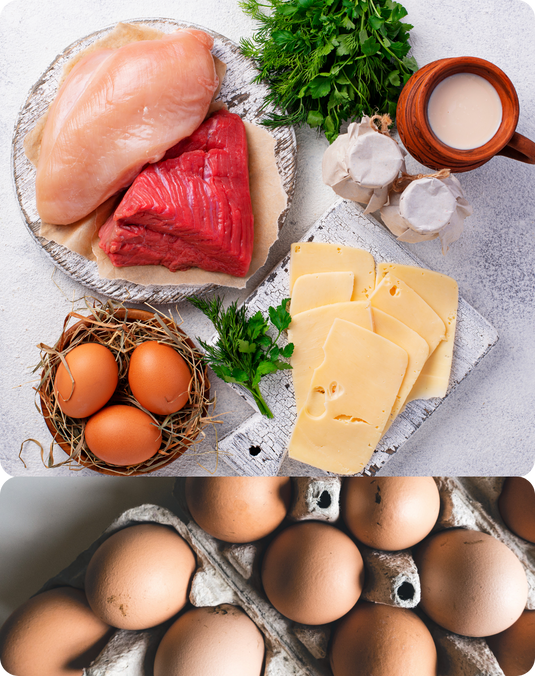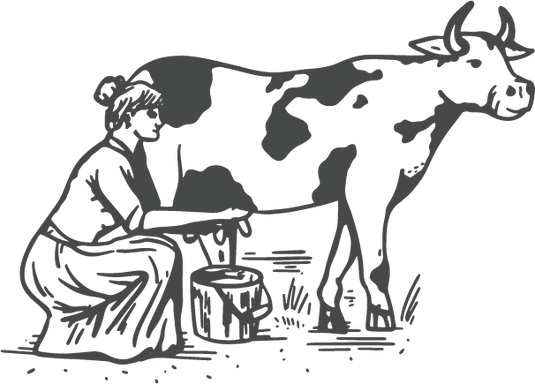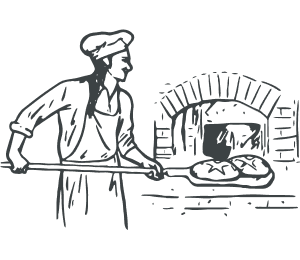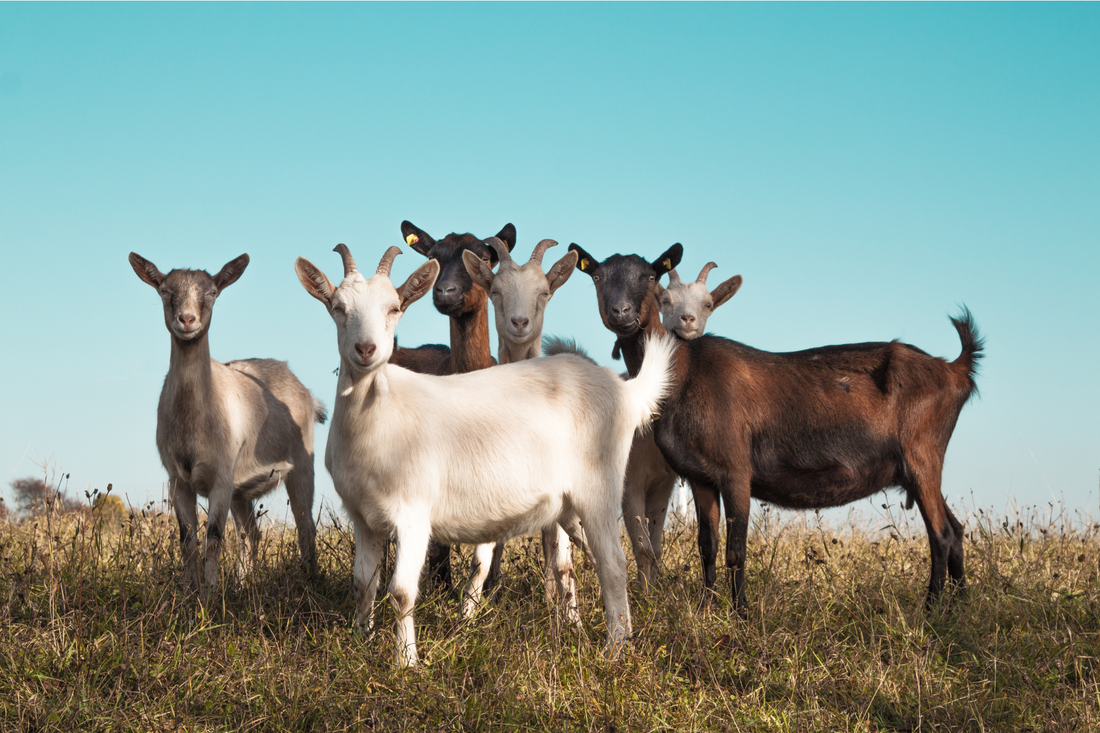

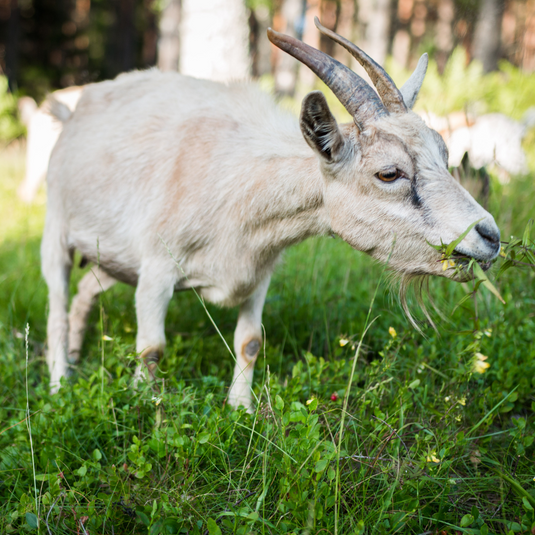
1. 100% Grass-Fed and Rotationally Grazed
The dairy goats on our partner farms enjoy a life of freedom, never confined and allowed to roam lush, regenerative pastures or dense, shrubby woodlands—exactly as goats are meant to. This natural environment lets them engage in instinctual behaviors, like cleaning and grooming their hooves on tree trunks, while benefiting from fresh air, abundant sunshine, and a strong connection to the land. Twice daily, they return to the milking parlor, where they briefly step onto the milking stand before returning to their pasture. During milking, they are offered a small portion of our custom-made Low PUFA grain, carefully crafted without corn, soy, or other high-PUFA ingredients like sunflower seeds and canola oil.
Dairy cows thrive on a 100% grass-fed diet due to their large rumen, which efficiently digests fibrous forage and extracts enough energy from grass. In contrast, dairy goats have a smaller rumen, higher metabolism, and faster digestion, making them natural browsers that need a more diverse and energy-rich diet. As a result, goats require some grain supplementation, even when raised on pasture, to maintain health and milk production. Historically, our ancestors supplemented dairy goats with regionally available grains like barley, oats, millet, and wheat bran, and we continue this ancestral approach to produce milk as nature intended.
Our farm partners implement regenerative rotational grazing, moving goats to fresh pasture daily while allowing previously grazed areas to recover. This method mimics natural flock movements and brings profound environmental benefits:
- Enhanced soil health and fertility
- Increased biodiversity in grass species and soil microbiome
- Improved carbon and water cycles
- Reduced parasite exposure
- Enhanced nutrient density in the final product
Unlike continuous grazing—where animals remain in one area too long, leading to overgrazing and soil depletion—this approach creates a self-sustaining cycle. Dairy goats forage intensively for a short period, then move on, allowing plants to fully regenerate. The result? Healthier land, richer forage, more resilient animals, and superior-quality meat and dairy.
When pastures become dormant in winter, our farm partners provide chemical-free, high-quality hay produced on their farms or sourced from approved locations. This ensures the goats continue receiving clean, nutrient-rich forage, maintaining peak health even in cold months. In extreme weather conditions, sheep are provided with shelter for safety and straw bedding to keep them warm and comfortable.

2. Superior Nutrient Profile, No Fatty Acid Manipulation
Unfortunately, most modern dairy goat feeds contain high-PUFA ingredients like corn oil, soy, canola, and sunflower seeds—far from what goats historically consumed. Research confirms that these fats pass into the milk, increasing PUFA content and reducing the saturated fat we actually want. To counter this, we created a one-of-a-kind LowPs™ feed designed to be more ancestrally consistent with what goats have eaten for centuries. While the dairy goats graze on lush pastures during the growing season, they are supplemented with this carefully formulated custom feed to support their health and milk production. By eliminating corn, soy, and other PUFA-rich ingredients, our goats produce milk that is naturally higher in saturated fats and lower in inflammatory polyunsaturated fats—giving you goat milk as Mother Nature intended.
This exclusive LowPs™ feed is uniquely formulated to be low in PUFAs, low in endocrine-disrupting Phytoestrogens, and low in Pesticides—something you won’t find anywhere else. Beyond crafting our own feed, we partner with regenerative row-crop farmers who grow our ingredients without synthetic pesticides. This gives us complete oversight of the process, ensuring our feed is as clean and wholesome as the dairy it helps produce.
Since the dairy goats are rotationally grazed on diverse pastures, their milk not only contains more vitamins and minerals, but it's also rich in beneficial phytochemicals, naturally occurring plant compounds with numerous health benefits. Terpenoids provide anti-inflammatory, anti-viral, and anti-carcinogenic properties, while polyphenols protect against cancer, cardiovascular disease, and diabetes, supporting immune function and gut health.
Rotationally grazed goats consume a wide variety of forages, each contributing unique phytochemicals. Research shows these compounds transfer directly into the milk, enhancing both nutritional value and flavor. Feedlot grain-fed goats consume virtually none of these beneficial compounds, while continuously grazed goats on a single plot access far fewer plant varieties. This is why truly regenerative, pasture-raised goat dairy is not only healthier—it also delivers the distinctive, rich flavor that only comes from a diverse, pasture-based diet.
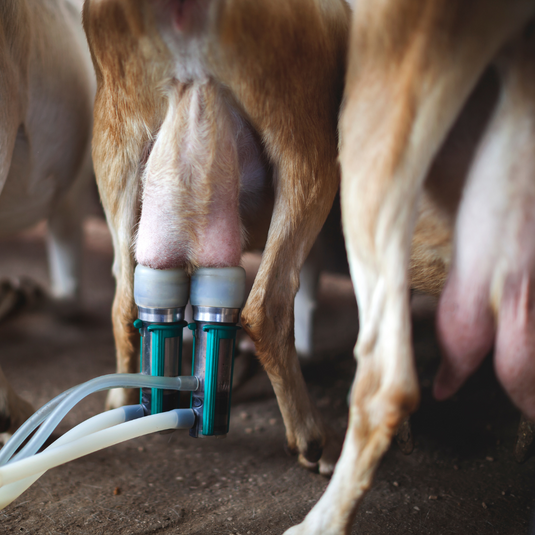
3. Sanitary milking conditions
A common misconception is that raw milk inherently contains harmful bacteria. In reality, contamination only occurs after the milk leaves the teats, and this happens solely due to unsanitary milking conditions. To uphold the highest standards of cleanliness and safety, our farm partners follow strict milking protocols.
Each morning and evening, the goats are brought in from pasture for milking. The milking equipment is meticulously sanitized with hot water and diluted hydrogen peroxide, and the milking area is diligently maintained for optimal hygiene. Before milking, the goats’ teats are carefully cleaned with a diluted iodine teat dip (0.5%). Lab testing confirms this diluted concentration does not artificially increase iodine levels in the milk. Maintaining clean, healthy udders is essential for preventing mastitis and ensuring milk safety.
Once collected by a milking machine, the milk is immediately transferred to a chill tank, where it is rapidly cooled to preserve freshness and prevent bacterial growth. It is then bottled on-farm, ensuring a single point of origin that keeps the milk safe and traceable. In contrast, conventional dairy combines milk from multiple farms into large vats, significantly increasing the risk of contamination.
To maintain these rigorous standards, milk is tested monthly for quality and pathogens. Additionally, a dedicated dairy field representative routinely visits each farm to oversee and support best practices. By prioritizing sanitation, traceability, and strict quality control, we ensure raw milk that is clean, safe, and nutrient-dense.
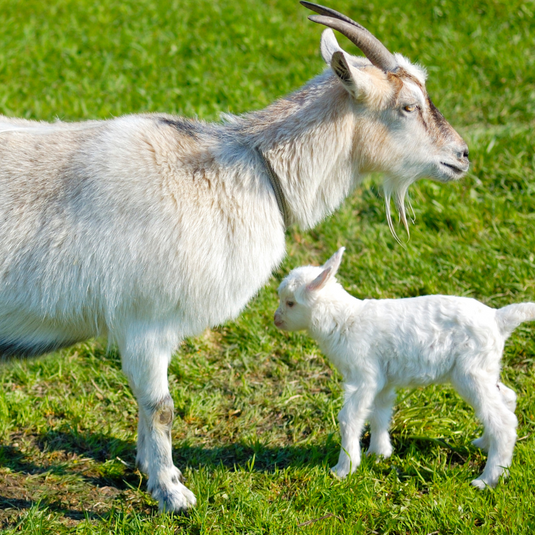
4. Lactation schedule aligned with the natural rhythms
Dairy goats, like sheep, do not produce milk year-round. Our farm partners work in harmony with their natural cycles to ensure their well-being. As seasonal breeders, dairy goats typically go into heat in the fall as daylight hours decrease. Their heat cycles last 18–21 days, with visible signs including tail wagging, vocalization, restlessness, and interest in the buck. After a 5-month pregnancy, they give birth in late winter or early spring, initiating their next lactation period. They are milked for 8 to 10 months before being dried off to rest in preparation for the next breeding season—and the natural cycle begins again!
Honoring this natural rhythm means there will be a brief period each year when fresh milk supply is lower. However, during this time, cheese continues to age, ensuring a steady supply of high-quality, matured dairy products year-round.
Milk production, like in humans, follows a birth cycle—milk is produced after kidding, and as long as the goat is milked regularly, lactation continues. This 8- to 10-month lactation period allows for milk production without requiring continuous pregnancies. But do not worry - goat kids are not deprived of milk in this model. They receive essential colostrum at birth and nurse for the early weeks, gradually transitioning to solid food (pasture) around 3 to 4 weeks of age. Regular breeding, lactation, and resting cycles ensure a steady supply of milk while respecting the natural rhythms of the animals.
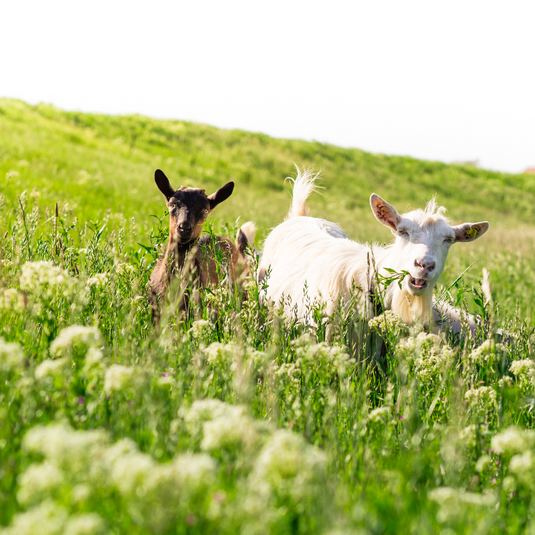
5. Needle-Free Production
At our partner farm, the goats thrive without pharmaceutical interventions because they are raised in optimal conditions—fresh pasture, clean air, regular rotation to new grass, and minimal waste exposure. This natural lifestyle reduces parasite exposure as the animals move to fresh ground regularly, eliminating the need for routine antibiotics, vaccines, hormones, and dewormers commonly used. In the rare event that an animal requires medical treatment to ensure its survival, it is removed from our Nourish production line. Herb tinctures are provided seasonally as a natural parasite prevention method as the goats transition from one season to the next.
This stands in stark contrast to feedlot operations, where confined conditions require constant interventions like insecticides for fly control, dewormers for parasite management, extensive vaccination programs, and routine antibiotics which contributes to the growing concerns of antibiotic resistance.
With every lactation, the goats give birth to lambs, who are raised with the goal of eventually entering the production line as they mature. This gradual process helps to grow the flock and steadily increase supply over time. Any dairy goats that are brought into the farm to expand, however, are from approved sources with the same rigorous standards. Crucially, the goat kids are raised without vaccines or pharmaceutical interventions, ensuring a needle-free flock with natural immunity. As a result, all of the dairy goats are born and raised on the farm, continuing the cycle of health and resilience.
By prioritizing regenerative practices, our farm partner fosters natural resilience in the herd. Diverse pastures provide immune-boosting compounds, regular movement minimizes parasite exposure, and freedom from confinement prevents stress-induced health issues. This holistic approach makes pharmaceutical interventions unnecessary, resulting in goats living in genuine health, producing pure, wholesome dairy just as nature intended.
